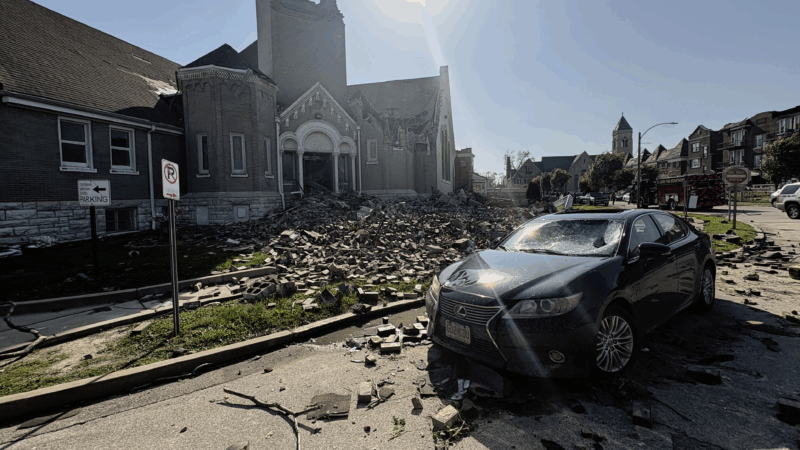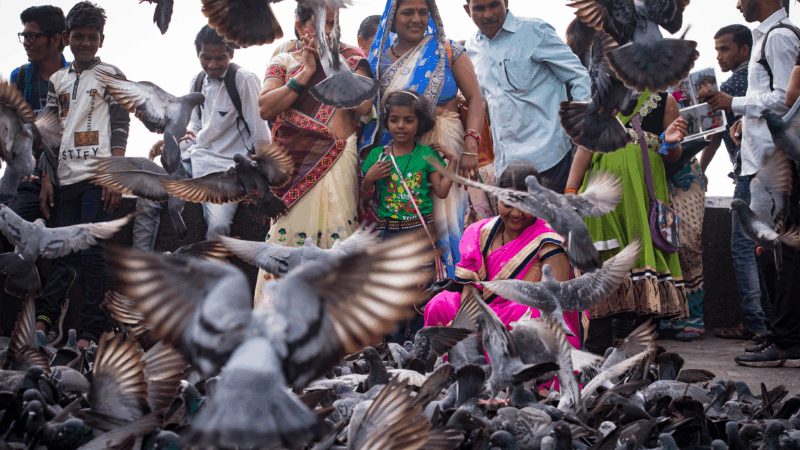At least 7 people dead and widespread damage left in the wake of severe Midwest storms
ST. LOUIS — At least seven people died and authorities were searching from building to building for people who were trapped or hurt after severe storms including at least one possible tornado swept through Missouri.
The storms were part of a severe weather system Friday that caused severe damage in Missouri, spawned tornadoes in Wisconsin, left hundreds of thousands without power in the Great Lakes region and brought a punishing heat wave to Texas.
The storms Friday afternoon tore roofs off buildings, blew out windows, ripped bricks off siding and yanked up trees and power lines. St. Louis Mayor Cara Spencer confirmed five deaths in her city and said more than 5,000 homes were affected and about 100,000 customers remained without electricity on Friday night.
“This is truly, truly devastating,” Spencer said, adding that the city was in the process of declaring an emergency and an overnight curfew Friday had been put into place in the neighborhoods with the most damage.
The number of people injured was not immediately known. Barnes-Jewish Hospital received 20 to 30 patients from the storm with some in serious condition and most expected to be discharged by Friday night, according to hospital spokesperson Laura High.
St. Louis Children’s Hospital received 15 patients with two of them expected to remain in the hospital into the weekend, she said.
National Weather Service radar indicated a tornado touched down between 2:30 p.m. and 2:50 p.m. in Clayton, Missouri, in the St. Louis area. The apparent tornado touched down in the area of Forest Park, home to the St. Louis Zoo and the site of the 1904 World’s Fair and Olympic Games the same year.
At Centennial Christian Church, City of St. Louis Fire Department Battalion Chief William Pollihan told The Associated Press that three people had to be rescued after part of the church crumbled. One of those people died.
Stacy Clark said his mother-in-law Patricia Penelton died in the church. He described her as a very active church volunteer who had many roles, including being part of the choir.
Jeffrey Simmons Sr., who lives across from the church, heard an alert on his phone and then the lights went out.
“And next thing you know, a lot of noise, heavy wind,” he said. He and his brother went into the basement. Later, he realized it was worse than he thought. “Everything was tore up.”
Downed trees and stop lights also caused traffic gridlock during the Friday afternoon commute and officials urged people to stay home.
The upper stories of the Harlem Taproom’s brick building were demolished when the storm came through, leaving piles of bricks around the outside. About 20 people were inside, but they huddled in the back of the building and none were hurt, the St. Louis Post-Dispatch reported.
John Randle, a 19-year-old University of Missouri-St. Louis student, said he and his girlfriend were at the St. Louis Art Museum during the storm and were hustled into the basement with about 150 other people.
They could hear tree branches and hail hitting the building’s windows and Randle went up a flight of stairs to the main entrance for about 10 seconds, he said.
“You could see the doors flying open, tree branches flying by and people running,” he said. “A lot of people were caught outside.”
Christy Childs, a Saint Louis Zoo spokesperson, said in a text that the zoo would remain closed Saturday because of downed trees and other damage. Childs said all animals were safe and that there were no reports of significant injuries to staff, guests or animals.
“We can’t definitively say whether or not it was a tornado — it likely was,” National Weather Service meteorologist Marshall Pfahler said.
A tornado struck in Scott County, about 130 miles (209 kilometers) south of St. Louis, killing two people, injuring several others and destroying multiple homes, Sheriff Derick Wheetley wrote on social media.
“Our first responders acted swiftly, even while the tornado was still active, putting themselves in harm’s way to provide immediate assistance and care to those injured,” he said.

Appalachia and Midwest face danger
Weather forecasters warned severe storms with possible tornadoes, hail and even hurricane-force winds could hobble parts of Appalachia and the Midwest on Friday.
The weather service warned of a rare tornado emergency around Marion, Illinois, on Friday evening, saying a tornado had been confirmed and was life-threatening. Reports of damage and injuries were not immediately available.
A dust storm warning was issued around the Chicago area Friday night. The weather service said a wall of dust extended along a 100-mile (161-kilometer) line from southwest of Chicago to northern Indiana that severely reduced visibility.
The National Weather Service said residents in Kentucky, southern Indiana, southern Illinois, parts of Tennessee, Missouri, Arkansas and Ohio should brace for intense storms that could include baseball-sized hail.
The weather service’s Storm Prediction Center said “strong, potentially long-track tornadoes and very large hail” could be expected. and the threat for damaging winds in excess of 75 mph (120 kph) would increase into Friday evening as storms grew into larger clusters.
Ahead of Friday night’s anticipated storm, Appalachian Power, which serves 1 million customers in West Virginia, Virginia and Tennessee, said it requested 1,700 additional workers from neighboring utilities along with sending its own crews from unaffected areas to assist with service restoration.
Faith Borden, a meteorologist in the National Weather Service Nashville office, said Friday that middle Tennessee could expect “all types of severe weather. Winds up to 70 mph. We’re talking seriously large hail up to 3 inches, which for us is big hail.”
Texas hit by heat wave
Texas faced searing heat. A heat advisory was issued for San Antonio and Austin, with temperatures at a blistering 95 F (35 C) to 105 (40.5 C). Parts of the southern East Coast, from Virginia to Florida, battled with heat in the 90s (32-37 C).
The National Weather Service Office for Austin/San Antonio said Friday the humidity coming in over the weekend was expected to make temperatures feel hotter.
“There are concerns of heat exhaustion for people that aren’t taking proper precautions when they’re outdoors,” meteorologist Jason Runyen said, advising those affected to take breaks and stay hydrated.
Overnight Thursday, storms accompanied by booming thunder, lightning displays and powerful winds swept through parts of Wisconsin, Illinois, northern Indiana and Michigan, leaving scores of trees down and thousands of homes without power.
Several tornadoes touched down Thursday in central Wisconsin. None of the twisters had received ratings Thursday, said Timm Uhlmann, a National Weather Service meteorologist in Green Bay.
“We’re still gathering reports,” Uhlmann said. “We’re assessing some of the damage and still getting video and pictures. The damage that we have is fairly widespread. There was a lot of large hail. In Eau Claire was one report of softball-sized hail.”
No injuries were immediately reported.
Surveys also were underway Friday of damage in Michigan to determine if any tornadoes touched down, said Steven Freitag, a meteorologist with the National Weather Service in White Lake Township, northwest of Detroit.
The storms were fueled by temperatures in the lower 80s Farenheit (26-29 C) stretching from Illinois into Michigan and activated by a cold front that pushed through, Freitag said.
By Friday night, customers in Michigan were seeing power return but nearly 190,000 remained without electricity. Power outages also were recorded into Friday night in more than a half-dozen other states including Missouri and Indiana.
The threat of severe weather in Chicago delayed a Beyoncé concert by about two hours Thursday at Soldier Field.
A ban on feeding pigeons ruffles lots of feathers in Mumbai
The pigeon population has exploded — a result of people feeding the birds. For some it's a holy duty and a way to connect to nature. Critics point to health risks tied to exposure to pigeon droppings.
‘Rosemead’ tells a tragic — and true — story
The new movie stars Lucy Liu as an ailing mother to Joe, played by Lawrence Shou as a teenager facing mental illness in his feature debut role.
From 400-year-old globes to cosmic shrouds: A Maine library brings maps to life
From 400-year-old globes to cosmic funeral shrouds, how the Osher Map Library in Maine shows people that maps aren't just for navigation — but windows into history, culture, and how we see the world.
Benin’s interior minister says a coup announced earlier has been foiled
Earlier, a group of soldiers had appeared on Benin 's state TV Sunday to announce the dissolution of the government in an apparent coup, the latest of many in West Africa.
A fire at a popular nightclub in India’s Goa state kills at least 25, officials say
At least 25 people, including tourists, were killed in a fire at a popular nightclub in India's Goa state, the state's chief minister said Sunday.
National parks fee-free calendar drops MLK Day, Juneteenth and adds Trump’s birthday
The Trump administration, which has railed against what it describes as "woke" policies, removed MLK Day and Juneteenth from next year's list of fare-exempt days for visitors at dozens of national parks.






